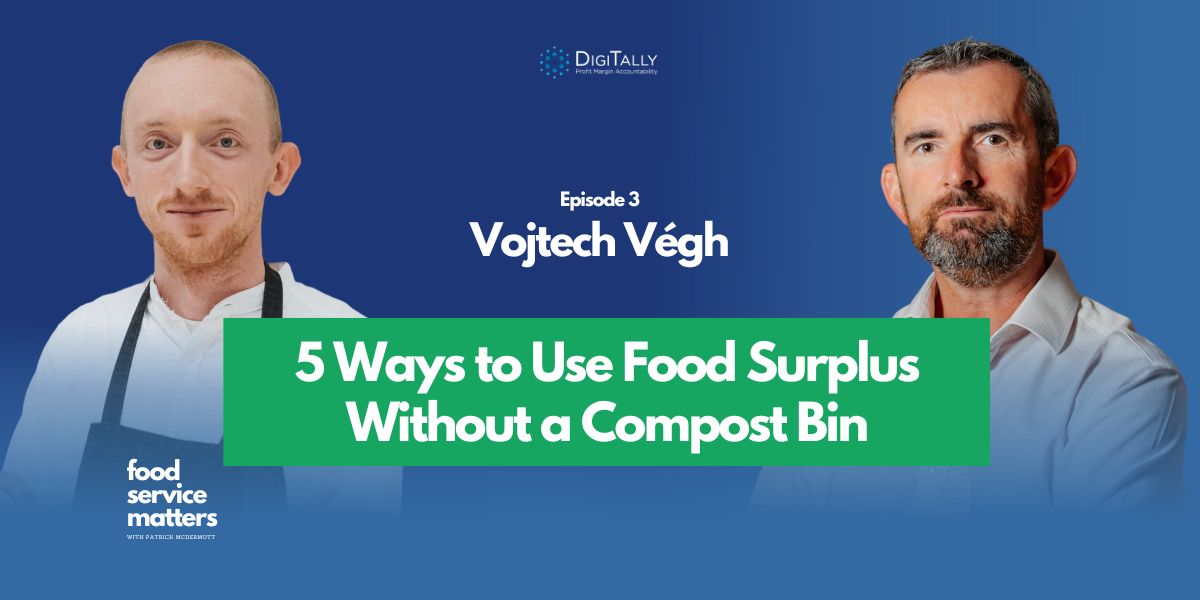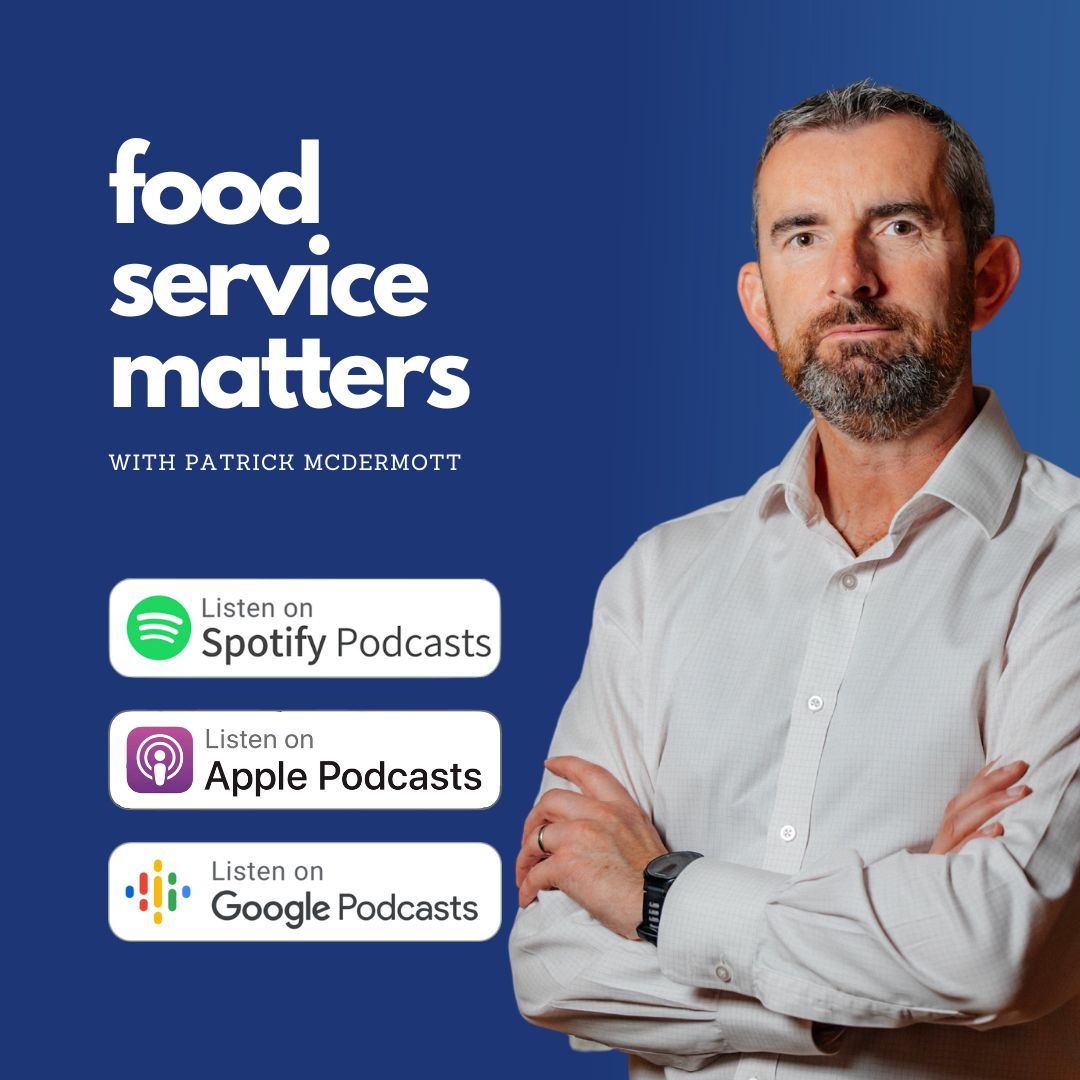“There are parts of our food that we can’t use – these go to composting.”
This has been accepted logic for years, but is it true? Is it possible to have no kitchen waste at all?
In episode three of the new Food Service Matters podcast, Patrick McDermott talks with Vojtech Végh – a plant-based chef and zero-waste guru who helps restaurants around the world reduce the amount of food they throw out. Vojtech is the author of Surplus: The Food Waste Guide for Chefs.
Together, Patrick and Vojtech delve into how to reduce kitchen scraps to reach a zero-waste target and think outside the box when reaching towards ESG objectives.
What’s wrong with composting?
Partick asks Vojtech, “Do you have a particular food waste item for which you say, ‘In every kitchen I enter, here’s the item that’s going to make a difference – can we eliminate this?’”
Vojtech replies, “Peels and leaves. The most common ingredients you see in bins are cauliflower leaves, broccoli stalks, potato peel, and all types of greens and tops, like carrot tops. Anything that is not considered the main part of the ingredient goes into the bin by default, even though in some cases it can be up to 50 per cent of the ingredient’s weight.”
What is the advantage of saving peels and leaves rather than just putting them in the compost bin? “You’ve paid for it already, so that could be a free ingredient in your recipe management system because you already have it. If you use the broccoli stem for stock when you currently waste it, then you’ve found a free ingredient.”
He adds, “For spoilage or things that simply can’t be safely eaten by humans anymore, compost is great. But if the food is edible, it belongs on the customer’s plate.”
How can you use your food surplus?
It’s all about having an open mind and being creative with your ingredients. How does Vojtech use ingredients that we generally put straight into the bin? Here are five of his suggestions:
Banana skins: Make pulled pork.
Vojtech says that he loves to make vegan pulled pork from banana skins.
“The banana skin’s fibre is just like that of a pork shoulder. You can use the same spices and the same approach as you would with meat. You’ll get the same result.”
Vojtech works with top chefs around the world, and tells Patrick, “The chefs are not able to tell the difference. They didn’t believe that it was actually banana. They were convinced that it was pork.”
Carrot tops: Make carrot salsa.
What should we do with carrot tops? “Definitely carrot salsa; it’s a flavour bomb.”
The salsa uses carrot greens, and you can base it on a traditional Italian salsa verde recipe.
Vojtech says, “I love the absolute simplicity of it, and carrot top salsa is a complete addiction in our household. It’s just so simple, easy, and flavourful.”
Coffee grinds: Make coffee syrup.
We don’t need to throw away our coffee grinds – certainly not when there is life in them yet! Vojtech suggests making coffee syrup.
Simply mix sugar with coffee grinds and any leftover coffee. Experiment and find the ratio you like best. You can add some spices, such as cardamom or cinnamon. Vojtech says, “You boil it down, boil it again, strain it, reduce it – then you have coffee syrup.”This is a delicious ingredient that you can use on desserts, in milkshakes, or, of course, in cocktails. Virgin White Russian, anyone?
Pineapple skin: Make tepache.
The best way to use your pineapple scraps, Vojtech says, is by making a tepache: a Mexican fermented drink made from pineapple skins.
For this effortless fermented drink, take the pineapple skins and core (for the added sugar content that helps fermentation), then add unrefined sugar (such as piloncillo or panela), add ginger, a cinnamon stick, and water – and leave it for a few days to ferment.
Voilà, a delicious drink for a hot summer’s day!
Potato peel: Leave it on.
Vojtech’s advice for potato peel is very simply to leave it on.
He says, “It’s way easier if you actually don’t create those byproducts. Don’t peel the vegetables, don’t trim this and that – keep it in one piece, use it as it is, and then you don’t have to spend time creating new products!”
Vojtech’s most important tip
Vojtech says doing all the “small fancy things with pickling and fermenting” is fun but might not be the solution you need in and of itself. Unless carefully built into your menu, your amount of scraps may often be inconsistent and a distraction from more effective solutions.
He says, “Ultimately, it’s not so much about reducing it once it’s happened; it’s about preventing it in the first place. It’s important to start from the top and actually reduce where the waste is created before you start.”
To listen to Patrick’s full interview with Vojtech, check out the Food Service Matters podcast.
If you want to measure and understand your kitchen wastage so that you can begin your journey to zero waste, this is where to start. Patrick is CEO of stocktaking app DigiTally, an intuitive stock management system that keeps your whole business up to date, helps reduce food waste, and saves time. Let’s talk! Click to book a 30-minute chat with Patrick and ask about setting up a demo.




